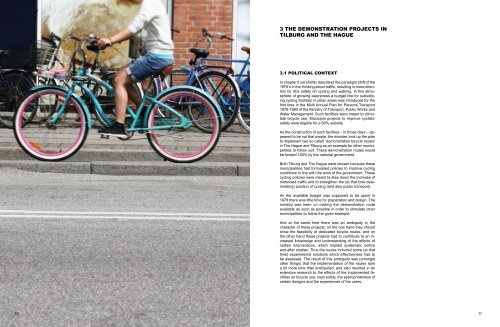Aalborg Universitet Bike Infrastructures Report Silva, Victor ... - VBN
Aalborg Universitet Bike Infrastructures Report Silva, Victor ... - VBN
Aalborg Universitet Bike Infrastructures Report Silva, Victor ... - VBN
Create successful ePaper yourself
Turn your PDF publications into a flip-book with our unique Google optimized e-Paper software.
3 The demonstration projects in<br />
Tilburg and The Hague<br />
3.1 Political context<br />
In chapter 2 we shortly described the paradigm shift of the<br />
1970’s in the thinking about traffic, resulting in more attention<br />
for (the safety of) cycling and walking. In this atmosphere<br />
of growing awareness a budget line for subsidizing<br />
cycling facilities in urban areas was introduced for the<br />
first time in the Multi Annual Plan for Persons Transport<br />
1976-1980 of the Ministry of Transport, Public Works and<br />
Water Management. Such facilities were meant to stimulate<br />
bicycle use. Municipal projects to improve cyclists’<br />
safety were eligible for a 80% subsidy.<br />
As the construction of such facilities – in those days – appeared<br />
to be not that simple, the minister took up the plan<br />
to implement two so called ‘demonstration bicycle routes’<br />
in The Hague and Tilburg as an example for other municipalities<br />
to follow suit. These demonstration routes would<br />
be funded 100% by the national government.<br />
Both Tilburg and The Hague were chosen because these<br />
municipalities had formulated policies to improve cycling<br />
conditions in line with the aims of the government. These<br />
cycling policies were meant to slow down the increase of<br />
motorised traffic and to strengthen the (at that time deteriorating)<br />
position of cycling (and also public transport).<br />
As the available budget was supposed to be spent in<br />
1976 there was little time for preparation and design. The<br />
ministry was keen on making the demonstration route<br />
available as soon as possible in order to stimulate other<br />
municipalities to follow the given example.<br />
And at the same time there was an ambiguity in the<br />
character of these projects: on the one hand they should<br />
show the feasibility of dedicated bicycle routes, and on<br />
the other hand these projects had to contribute to an increased<br />
knowledge and understanding of the effects of<br />
certain interventions, which implied systematic before<br />
and after studies. Thus the routes included some (at that<br />
time) experimental solutions which effectiveness had to<br />
be assessed. The result of this ambiguity was (amongst<br />
other things) that the implementation of the routes took<br />
a bit more time than anticipated, and also resulted in an<br />
extensive research to the effects of the implemented facilities<br />
on bicycle use, road safety, the appropriateness of<br />
certain designs and the experiences of the users.<br />
10 11
















